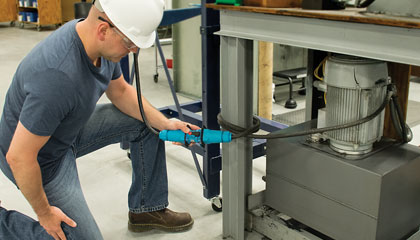NFPA 70E/CSA Z462 – Workplace Standard for Electrical Safety


NFPA 70E/CSA-Z462 -The Standard for Electrical Safety in the Workplace
As the foremost consensus standard for electrical safety in the workplace, NFPA 70E is the primary resource for employers to use in determining how to comply with OSHA’s electrical safety regulations. It is also used by OSHA and the courts in the investigation of injuries to assess whether or not the involved employers took reasonable steps and precautions to protect their employees.
The 70E standard was developed in the U.S., but has been largely adopted in Canada’s CSA-Z462 ‘Workplace Electrical Safety’ standard and is also increasingly recognized and used in Mexico. The key elements summarized below will generally apply in all three countries. Consult the standards for complete details.
Article 110 – General Requirements for Electrical Safety–Related Work Practices
The OSHA CFR 1910.333 Standard is quite clear about employer’s responsibilities: Section (a) states that “safety-related work practices shall be employed to prevent electric shock or other injuries resulting from either direct or indirect electrical contacts, when work is performed near or on equipment or circuits which are or may be energized. The specific safety-related work practices shall be consistent with the nature and extent of the associated electrical hazards.”
Article 110 of the NFPA 70E standard provides helpful guidance on how these and other associated legal requirements in the OSHA Standard can be met.
Electrically Safe Work Condition:
First Priority: Hazard Elimination
Hazard elimination is specifically identified as the first priority in the implementation of safety-related work
practices, and accordingly is the first method listed in the Hierarchy of Risk Control Methods to be employed:
(1) Elimination (2) Substitution (3) Engineering Controls (4) Awareness (5) Administrative Controls (6) PPE
It is important to note that the use of PPE is indicated as the least effective risk control method. If a hazard can be eliminated, it should be eliminated; there is no risk of injury if hazards do not exist.
110.2(B) Compliance
The OSHA CFR 1910.333 Standard also requires, in section (a)(1), that “live parts (above 50 V) to which an
employee may be exposed shall be de-energized before the employee works on or near them, unless the
employer can demonstrate that de-energizing introduces additional or increased hazards or is infeasible
due to equipment design or operational limitations.”
Thus, an employer’s Electrical Safety-Related Work Practices must include the determination of when it is necessary to establish an Electrically Safe Work Condition by disconnecting and isolating the circuit parts to be worked on from the energized circuit.
Energized electrical conductors and circuit parts operating at 50 V or more, are required to be placed into an electrically safe work condition before work can begin, if:
-
The activity is not a permitted normal operation of energized equipment
-
The employee is within the limited approach boundary
-
There is an increased likelihood of injury from an exposure to arc flash hazards
Exception: Normal Operation
Normal operation of energized electric equipment shall be permitted provided the equipment is properly installed, maintained, and rated for the available fault current, with no evidence of impending failure; and is being used for its intended function in accordance with the manufacturer’s instructions, labeling and listings, and with any doors or covers closed and secured. Normal operation refers to using the equipment, not working on it.
Justification for Energized Work
Only after all opportunities to establish an electrically safe work condition have been exhausted should the decision be made to work on, or near, energized electrical conductors and circuit parts. Work on energized parts at 50 V or more should only be performed if the employer considers the capacity of the source and any overcurrent protection can demonstrate that de-energizing will introduce additional hazards, or is not feasible due to equipment design or operational limitations.
Electrical Safety Program
Another key work practice requirement is the maintenance of a documented electrical safety program to direct employee activities in a manner appropriate for the different voltage, energy level, and circuit conditions that may be
encountered. The program must address inspections, maintenance, employee awareness and self-discipline, electrical safety principles, emergency response plans, and procedures, risk assessment and control, job planning,
communication, and scope changes, incident investigations, electrically safe work condition policy, lockout/tagout, audits, and documentation.
Training Requirements
Employees who may be exposed to electrical hazards must be specifically trained to understand the hazards associated with electrical energy, as well as the safety-related work practices and procedures required to provide protection from them. The level of training an employee receives determines the tasks he/she is qualified to perform.
Only ‘Qualified Persons’ with appropriate training may perform work on or near exposed and energized electrical conductors or circuit parts. The training requirements include:
-
Recognizing and assessing potential hazards and risk control methods
-
Distinguishing energized from non-energized parts and determining the voltage
-
Understanding the relationship between the hazard and potential injury
-
Determining approach and flash protection boundaries
-
Selecting appropriate personal protective equipment and tools
-
Specific work practices and procedures to be followed
-
Lockout/tagout procedures
-
Emergency procedures for assisting victims of electrical incidents
Article 120 – Establishing an Electrically Safe Work Condition
The most effective way to prevent electrical injury is to eliminate the hazards by establishing an electrically safe work condition. To do so, workers must identify and disconnect all possible sources of electrical energy and prevent its reappearance through effective lockout/tagout procedures.
This article of the standard focuses heavily on lockout/tagout principles, equipment, and procedures. It defines the following eight-step procedure for establishing and verifying an electrically safe work condition.
Process for Establishing and Verifying an Electrically Safe Work Condition
Establishing and verifying an electrically safe work condition shall include all of the following steps, which shall be performed in the order presented, if feasible:
Determine all possible sources of electrical supply to the specific equipment. Check applicable up-to-date drawings, diagrams, and identification tags.
After properly interrupting the load current, open the disconnecting device(s) for each source.
Wherever possible, visually verify that all blades of the disconnecting devices are fully open or that drawout-type circuit breakers are withdrawn to the test or fully disconnected position.
Release stored electrical energy.
Block or relieve stored nonelectrical energy in devices to the extent the circuit parts cannot be unintentionally energized by such devices.
Apply lockout/tagout devices in accordance with a documented and established procedure.
Use an adequately rated portable test instrument to test each phase conductor or circuit part at each point of work to test for the absence of voltage. Test each phase conductor or circuit part both phase-to-phase and phase-to-ground. Before and after each test, determine that the test instrument is operating satisfactorily through verification on any known voltage source. (Refer to NFPA 70E 2024 Article 120.6 for exceptions)
Where the possibility of induced voltages or stored electrical energy exists, ground all circuit conductors and circuit parts before touching them. Where it could be reasonably anticipated that the conductors or circuit parts being de-energized could contact other exposed energized conductors or circuit parts, apply temporary protective grounding
equipment in accordance with guidelines in NFPA 70E 2024 Article 120.6.
Article 130 – Work Involving Electrical Hazards
When electrical conductors and circuits equal to and greater than 50 V cannot be placed into an electrically safe work condition, and work is performed as permitted in accordance with NFPA 70E Section 110.2(B), the following requirements must be met:
Only qualified persons shall be permitted to work on electrical conductors or circuit parts that have not been put into an
electrically safe work condition.
An energized electrical work permit shall be completed as required by NFPA 70E 2024 Article 130.2.
An electric shock risk assessment shall be performed as required by NFPA 70E 2024 Article 130.4.
Work Permit
When non-routine work must be performed on energized parts or within the restricted approach boundary, a detailed work permit must be prepared before the work can begin. The work permit must document the following elements and be approved/signed by a responsible owner, manager, or safety officer:
-
The location and description of the circuit and equipment to be worked on
-
A description of the work to be performed
-
Justification for performing the work in an energized condition
-
A description of the safe work practices to be employed
-
Results of the electric shock risk assessment to include voltage exposed, limited approach boundary, and personal and other protective equipment
-
Results of the arc flash risk assessment to determine the incident energy at the working distance or arc flash PPE category, personal protective equipment required for worker safety, and the arc flash protection boundary
-
Restricted access of unqualified persons from the work area
-
Evidence that the job briefing has been completed
-
Needs energized work approval signatures by authorized or responsible management, safety officer, or owner
Electric Shock Risk Assessment and Approach Boundaries
An electric shock risk assessment shall be performed to identify electric shock hazards, estimate the likelihood and severity of injury or damage, and determine the associated required protective measures, including PPE. Because personnel will approach energized electrical conductors or other live circuit parts, limited and restricted approach boundaries must be determined in order to identify safe approach distances and the precautions required to minimize the possibility of electric shock. These boundaries are determined by consulting tables 130.4(E)(a) and (b) in the standard based on voltage and conductor type.
Arc Flash Risk Assessment
An arc flash risk assessment shall also be performed by a qualified person to identify arc flash hazards, estimate the likelihood and severity of injury or damage, and to determine if additional protective measures, including PPE, are required. As a part of this assessment, arc flash protection boundaries must be determined based on the incident energy, and will be the distance at which the incident energy equals 1.2 cal/cm². The distances for common equipment and voltage levels are provided by table 130.7(C)(15)(a) and (b) in the standard. Others must be determined by specific calculation.
Personal and Other Protective Equipment
Employees working in areas where electrical hazards are present must be qualified to perform the work. They must be provided with, and use, protective equipment designed and constructed for the specific part of the body to be protected and for the work to be performed. PPE requirements can be determined from tables in the standard, based either on the calculated incident energy level, or on the PPE category assigned to the type and electrical energy characteristics of the equipment being worked on.
Section 130.7(C)(15) provides details on selection of appropriate arc rated PPE. Four categories of increasingly protective PPE are defined based on the minimum level of incident energy they provide protection against. The PPE category required can be determined by calculation of the incident energy level or by consulting the table identifying PPE categories for common equipment and voltage levels.
MELTRIC Simplifies NFPA 70E Compliance
MELTRIC Switch-Rated plugs and receptacles simplify compliance with NFPA 70E by eliminating exposure to live parts and arcing when making and breaking electrical connections to changeout or service motors and other equipment. The hazard is eliminated, so there is no need for cumbersome PPE or time-consuming safety procedures.
MELTRIC Switch-Rated plugs and receptacles are designed specifically to ensure safe use and are UL/CSA rated for branch circuit and motor circuit disconnect switching.
-
They have a quick break mechanism that automatically ejects the plug to the ‘Off’ position and minimizes associated arcing.
-
Arcing that does occur is safely contained and isolated in internal arc chambers.
-
The design of the casings prevents access to live parts when the plug is ejected to the ‘Off’ position; this dead-front is maintained by a safety shutter which closes automatically over the receptacle contacts before the plug can be removed.
At no time in the process is the user subject to potential electrical hazards. Making and breaking connections with them is an NFPA 70E “Normal Operation” and requires no PPE or special precautions.
In addition to eliminating the potential hazards common with pin and sleeve and other types of plugs and receptacles, MELTRIC Switch-Rated plugs and receptacles simplify NFPA 70E compliance by making it easy to establish an electrically safe working condition:
-
They provide the safe and proper means of interrupting the load current.
-
The removal of the plug from the receptacle provides clear visual verification of deenergization without the voltage testing required on bladed disconnects and rotary switches.
-
Integral provisions make lockout/tagout simple on either the plug or the receptacle.
-
Work can be done without the need for specially qualified personnel.








